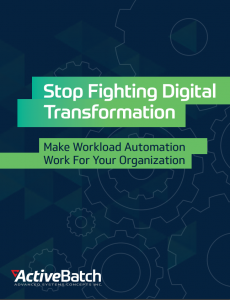Everyone likes having a shorthand, especially in IT. But long lists of obscure acronyms are tough to keep track of. So as a service to IT personnel everywhere (and also for ourselves) we’ve compiled a definitive list of IT’s most common abbreviations.
A Complete List Of IT Acronyms And Abbreviations
AI
Artificial Intelligence
AI uses machine learning algorithms to analyze large volumes of data (historical or real-time) to detect anomalies such as errors and patterns such as CPU spikes. AI-enabled systems will then take action in response to events or to prevent a predicted error.
AES
Advanced Encryption Standard
A specification for the encryption of electronic data created in 2001 by the U.S. National Institute of Standards and Technology. It is a symmetric-key algorithm, using the same key for encrypting and decrypting the data. Adopted by the U.S. government, it replaced the Data Encryption Standard (DES).
AIOps
Artificial Intelligence For IT Operations
The use of AI to collect, analyze and react to historical and real-time data, often without human interaction. AIOps helps IT to monitor processes and systems in real-time, searching for errors and trends and responding to events in real-time.
APM
Application Portfolio Management
Sometimes referred to as Asset Performance Management, APM tools collect data and metrics on software applications, IT infrastructure and hardware to determine each tool’s benefit or value to the organization. Monitoring performance of software can also help maintain service levels by reporting on system health.
API
Application Programming Interface
An API is a software interface that enables one application to interact with services provided by another application. An API specification describes how to communicate with a specific application.
APIM
Application Programming Interface Management
Application Programming Interface Management is a tool used by developers in all phases of the lifecycle – from access to analysis – to manage application programming interfaces (APIs).
AS2
AS2 (Application Statement 2)
Applicability Statement 2, is a widely-used specification for securely transporting Electronic Data Interchange (EDI) data over the internet, employing HTTPS and S/MIME encryption for reliable and secure B2B data exchanges.
BI
Business Intelligence
BI refers to the processes and tools used to collect, analyze and report on business data. Information provided by BI platforms can be used in decision-making for most functions within an organization.
BPA
Business Process Automation
BPA solutions are used to develop, monitor, automate and optimize digital processes.
BPM
Business Process Management
BPM solutions are used to optimize business workflows through modeling, analyzing, measuring and automating processes.
CHAP
Challenge-Handshake Authentication Protocol
An authentication protocol used in Point-to-Point Protocol to validate users in most network operating systems. It’s also used in other protocols such as RADIUS and Diameter.
CISO
Chief Information Security Officer
A senior-level executive responsible for managing and reducing cybersecurity risks in IT.
CI/CD
Continuous Integration/Continuous Delivery
CD/CI refers to the practice of merging developers’ working copies multiple times each day, while continuously delivering software iterations in short development cycles.
CRM
Customer Relationship Management
CRM solutions enable organizations to manage the processes that provide services to customers. This often involves the use of CRM databases that store key customer information.
DAM
Database Activity Monitoring
DAM is a database security technology for monitoring and database analytics. It has the ability to bring together data from both network-based monitoring as well as native audit information so users have a full view of the database activity.
DBMS
Database Management System
A DBMS provides an interface that is used to create and manage databases. A DBMS provides centralized access and control and can be used to create, protect, retrieve, read and manipulate data.
DES
Data Encryption Standard
An outdated encryption standard that was replaced by Advanced Encryption Standard (AES) in 2001. Its 56 key length isn’t secure enough for current applications, but it played a role in the development of cryptography.
DMI
Desktop Management Interface
The Desktop Management Interface is used to create a standard framework for managing and tracking components in servers, desktops and notebooks. It was the first method used to provide standardized information about personal computer components.
DevOps
Development Operations
DevOps is a set of practices, methodologies and tools that are used to speed-up the development lifecycle by fostering greater collaboration between development and operations teams.
DPA
Digital Process Automation
DPA solutions are typically low-code platforms that enable users to develop processes or workflows. Compared to business process automation, DPA tools focus more on building and maintaining customer-facing services that require disparate applications.
DX
Digital Transformation
DX refers to the use of digital technologies to create to new business models and to recreate legacy processes. Many new or emerging technologies are common in DX initiatives including multi-cloud, analytics, artificial intelligence and big data.
ERP
Enterprise Resource Planning
ERP refers to the practice of using BPM software to organize and automate all aspects of an operation with a single platform.
ETL
Extract, Transform, Load
ETL is the process of taking data from one database and adding it to another database — retrieving and manipulating data so that the receiving database can successfully handle the data.
FTP
File Transfer Protocol
FTP is a protocol used to transmit files between computers. FTP was first introduced in 1971. FTP does not provide encryption and is considered unsecured.
IPA
Intelligent Process Automation
The use of automation for business and IT processes to improve performance, provide orchestration and reduce or eliminate manual work and errors.
IA
Intelligent Automation
IA refers to IT automation tools that use machine learning or artificial intelligence to manage processes and infrastructure. IA tools are used to monitor IT operations environments and to resolve issues without human intervention.
IaaS
Infrastructure-as-a-Service
IaaS vendors provide cloud-based infrastructure often through a pay-as-you-go subscription model. IaaS hardware and software are owned by the service provider and can be hosted by the service provider or on-premises.
I&O
Infrastructure And Operations
I&O is a term used by Gartner to distinguish infrastructure and operations as a singular unit that is distinct from the rest of IT. In this context, I&O is responsible for managing the resources that developers, help desks and business teams rely on.
IoT
Internet of Things
IoT refers to a network of real-world devices that can interact and share data and information with other endpoints and remote data centers.
IDS
Intrusion Detection System
Also known as Intrusion Prevention System (IPS), this is either an application or device used to look for malicious activity on a network. Reports are typically sent through to a security information and event management system (SIEM) where it is reviewed and prioritized for legitimacy and threat level.
ITPA
IT Process Automation
ITPA is the practice of using automated workflows to coordinate, integrate, and manage digital tools and processes with the goal of saving IT personnel time.
MFT
Managed File Transfer
MFT solutions enable organizations to securely transfer files between internal and external servers. MFT software can typically handle multiple file transfer protocols and will provide additional layers of security such as encryption, tunneling and authorization.
ML
Machine Learning
ML algorithms are used to analyze historical and real-time data in order to improve predictions and models as more data is produced. ML is a foundational technology for AI and other intelligent tools.
OLAP
Online Analytical Processing
OLAP software can perform multidimensional analyses of data, often applied to BI applications. OLAP enables users to make ad hoc analyses and complex analytical calculations that can suggest anticipated outcomes of scenarios.
OLTP
Online Transaction Processing
OLTP refers to software programs that support transactions over the internet, including data entry, order entry, financial transactions, etc. OLTP systems usually involve large numbers of users making quick, simple transactions, for instance in retail.
PAP
Password Authentication Protocol
Used in Point-to-Point Protocol (PPP), this password-based authentication is used to validate users. It’s considered a weak protocol and more vulnerable to attack than other, more advanced protocols like Transport Layer Security (TSL).
PaaS
Platform-as-a-Service
PaaS vendors provide cloud-based development environments often through a pay-as-you-go subscription model. PaaS hardware and software are owned by the service provider and can be hosted by the service provider or on-premises.
RBA
Runbook Automation
RBA solutions are used to automate collections of standardized, routine procedures in response to events such as IT tickets, service requests or alerts.
REST API
Representational State Transfer
Architectural style, also known as RESTful web services, that allow different applications to interact. REST APIs use this architectural style to interact with other REST web services. Automation platforms support this style as a way to connect with other applications.
RPA
Robotic Process Automation
RPA refers to software scripts that perform rules-based tasks at the application layer. Common examples include data entry and screen-scraping.
SaaS
Software-as-a-Service
SaaS vendors provide cloud-based applications often through a pay-as-you-go subscription model. SaaS software is owned by the service provider and can be hosted by the service provider or on-premises.
SDN
Software-Defined Networking
A newer approach to network management, Software-Defined Networking gives users the ability to create a network structure that resembles more of a cloud architecture approach. Its dynamic methodology improves both network monitoring and performance.
SFTP
SSH File Transfer Protocol
SFTP uses SSH to transfer, manage and access files over an unsecured network. SFTP and FTPS are both understood as “secure” file transfer protocols, in comparison to unencrypted protocols such as FTP.
SLA
Service Level Agreement
An SLA is a contract that defines what services will be provided to the client, when those services are to be rendered by, what procedures should be taken if something goes wrong, and what will happen if either party breaches the contract.
SOAP
Service Orchestration And Automation Platform
SOAP solutions enable organizations to centrally manage automated workloads and processes, as well as the infrastructure resources those workloads require. SOAPs are typically designed for cloud-based or hybrid IT workloads.
SSH
Secure Shell
Secure Shell is a protocol that encrypts data being sent to and from a remote server. SSH also allows authentication of users.
VM
Virtual Machine
Virtual machines are virtualized representations of computer systems. Each VM has its own sandboxed environment on a host server, which can have multiple VMs running simultaneously. Each VM instant has its own separate operating system and is a standalone service.
WLA
Workload Automation
WLA platforms enable organizations to develop, monitor and manage automated applications and the infrastructure resources those applications (or workloads) require to complete successfully.
WLA&O
Workload Automation & Orchestration
A software solution that provides workload automation for business and IT processes as well as a centralized platform that allows users to orchestrate all the organization’s processes in one place.
Don’t Let IT Complexity Hamper Your Digital Goals
Get the latest trends and data on what’s driving transformation and how IT teams are addressing these challenges.

